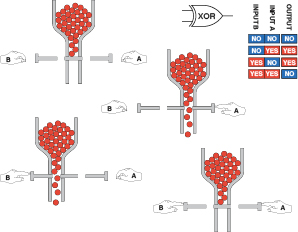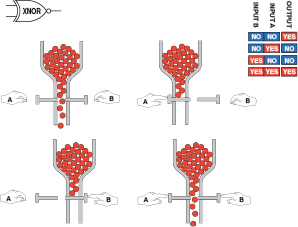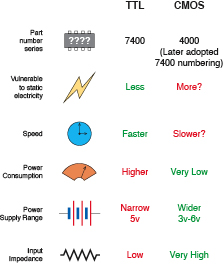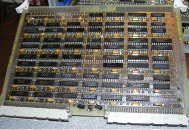Make: Electronics (55 page)
Authors: Charles Platt

Essentials
Logic gate basics (continued)

Figure 4-62
.

Background
The confusing world of TTL and CMOS
Back in the 1960s, the first logic gates were built with Transistor-Transistor Logic, abbreviated TTL, meaning that tiny bipolar transistors were etched into a single wafer of silicon. Soon, these were followed by Complementary Metal Oxide Semiconductors, abbreviated CMOS. Each of these chips was a collection of metal-oxide field-effect transistors (known as MOSFETs). The 4026 chip that you used earlier is an old CMOS.
You may remember that bipolar transistors amplify current. TTL circuits are similar: they are sensitive to current, rather than voltage. Thus they require a significant flow of electricity, to function. But CMOS chips are like the programmable unijunction transistor that I featured previously. They are voltage-sensitive, enabling them to draw hardly any current while they are waiting for a signal, or pausing after emitting a signal.
The two families named TTL and CMOS still exist today. The table in Figure 4-64 summarizes their basic advantages and disadvantages. The CMOS series, with part numbers from 4000 upward, were easily damaged by static electricity but were valuable because of their meager power consumption. The TTL series, with part numbers from 7400 upward, used much more power but were less sensitive and very fast. So, if you wanted to build a computer, you used the TTL family, but if you wanted to build a little gizmo that would run for weeks on a small battery, you used the CMOS family.
From this point on everything became extremely confusing, because CMOS manufacturers wanted to grab market share by emulating the advantages of TTL chips. Newer generations of CMOS chips even changed their part numbers to begin with “74” to emphasize their compatibility, and the functions of pins on CMOS chips were swapped around to match the functions of pins on TTL chips. Consequently, the pinouts of CMOS and TTL chips are usually now identical, but the meaning of “high” and “low” states changed in each new generation, and the maximum supply voltages for CMOS chips were revised downward. Note I have included question marks beside two categories in the CMOS column, as modern CMOS chips have overcome those disadvantages—at least to some extent.
Here’s a quick summary, which will be useful to you if you look at a circuit that you find online, and you wonder about the chips that have been specified.
Where you see a letter “x,” it means that various numbers may appear in that location. Thus “74xx” includes the 7400 NAND gate, the 7402 NOR gate, the 74150 16-bit data selector, and so on. A combination of letters preceding the “74” identifies the chip manufacturer, while letters following the part number may identify the style of package, may indicate whether it contains heavy metals that are environmentally toxic, and other details.

Figure 4-64.
The basic differences between the two families of logic chips. In successive generations, these differences have gradually diminished.
TTL family:
74xx
The old original generation, now obsolete.
74Sxx
Higher speed “Schottky” series, now obsolete.
74LSxx
Lower power Schottky series, still used occasionally.
74ALSxx
Advanced low-power Schottky.
74Fxx
Faster than the ALS series.
Background
The confusing world of TTL and CMOS (continued)
CMOS family:
40xx
The old original generation, now obsolete.
40xxB
The 4000B series was improved but still susceptible to damage from static electricity. Many hobby circuits still use these chips because they will run from relatively high voltages and can power LEDs and even small relays directly.
74HCxx
Higher-speed CMOS, with part numbers matching the TTL family, and pinouts matching the TTL family, but input and output voltages not quite the same as the TTL family. I’ve used this generation extensively in this book, because it’s widely available, and the circuits here have no need for greater speed or power.
74HCTxx
Like the HC series but matching the TTL voltages.
74ACxx
Advanced version of HC series. Faster, with higher output capacity.
74ACTxx
Like the AC series but with the same pin functions and voltages as TTL.
74AHCxx
Advanced higher-speed CMOS.
74AHCTxx
Like the AHC series but with the same pin functions and voltages as TTL.
74LVxx
Lower voltage (3.3v) versions, including LV, LVC, LVT, and ALVC series.
As you can see, these days you have to interpret part numbers very carefully. But which family and generation of chips should you use? Well, that depends! Following are some guidelines.
What you don’t need:
1.
Speed differences are irrelevant from our point of view, as we’re not going to be building circuits running at millions of cycles per second.
2.
Price differences are so small as to be inconsequential.
3.
Lower-voltage (LV) CMOS chips are not very interesting for our small experimental circuits.
4.
Try to avoid mixing different families, and different generations of the same family, in the same circuit. They may not be compatible.
5.
Some modern chip varieties may be only available in the surface-mount package format. Because they’re so much more difficult to deal with, and their only major advantage is miniaturization, I don’t recommend them.
6.
In the TTL family, the LS and ALS series cannot handle as much output current as the S series and the F series. You don’t need them.
What you should use:
1.
The old 74LSxx series of TTL chips was so popular, you’ll still find schematics that specify these chips. You should still be able to buy them from sources online, but if not, you can substitute the 74HCTxx chips, which are designed to function identically.
2.
The old 4000B series of CMOS chips are still used by hobbyists because their willingness to tolerate high voltages is convenient. While TTL or TTL-compatible chips require a carefully regulated 5 volts, the 4000B chips would handle 15 volts—and also delivered enough power to energize LEDs or even very small relays. Some hobbyists also have a nostalgic affection for the 74Cxx series of chips, which had the same pin connections as the TTL chips but could still tolerate higher voltages and higher output current. The trouble is, some of the 74Cxx chips are almost extinct, and while the 4000B chips are still available, they are considered almost obsolete.
Background
The confusing world of TTL and CMOS (continued)
Bottom line: I suggest you use the 4000B chips only if you want to replicate an old circuit, or if a modern equivalent is unavailable (which is why I specified the 4026B chip for the reaction timer—I could not find a modern equivalent that will drive seven-segment numeric displays directly, and I didn’t want you to have to deal with more parts than necessary).
If you check online suppliers such as
Mouser.com
you’ll find that the HC family is by far the most popular right now. They are all available in through-hole format (to fit your breadboard and perforated board). They have the high input impedance of CMOS (which is useful) and they have the same pin identities as the old 74LSxx series.
Abbreviations
When looking at data sheets, you are likely to encounter some or all of these abbreviations:
- VOH min: Minimum output voltage in high state
- VOL max: Maximum output voltage in low state
- VIH min: Minimum input voltage to be recognized as high
- VIL max: Maximum input voltage recognized as low
Background
Logic gate origins
The 7400 family of integrated circuits was introduced by Texas Instruments, beginning with the 7400 NAND gate in 1962. Other companies had sold logic chips previously, but the 7400 series came to dominate the market. The Apollo lunar missions used a computer built with 7400 chips, and they were a mainstay of minicomputers during the 1970s.
RCA introduced its 4000 series of logic chips in 1968, built around CMOS transistors; Texas Instruments had chosen TTL. The CMOS chips used less power, thus generating much less heat and enabling flexible circuit design, as each chip could power many others. CMOS was also tolerant of wide voltage ranges (from 3 to 15 volts) but prohibited switching speeds faster than around 1MHz. TTL was 10 times faster.
Design tweaks gradually eradicated the speed penalty for CMOS, and TTL chips have become relatively rare. Still, some people retain a special nostalgic loyalty to “the logic gates that went to the moon.” A hardcore enthusiast named Bill Buzbee has built an entire web server from TTL-type 7400 chips, currently online at
http://magic-1.org
. Figure 4-65 shows just one of the handmade circuit boards that Bill assembled to run his computer.

Figure 4-65.
Hobbyist Bill Buzbee built himself a web server entirely from 7400 series logic chips, the oldest of which was fabricated back in 1969. The web server can be found online at http://magic-1.org, displaying pictures of itself and details of its construction. The picture here that Bill took shows just one of the circuit boards of this remarkable project.